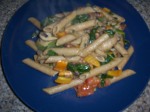 These delicious tomatoes are prepared using an adaptation of Jamie Oliver’s recipe. However we were short on basil, and despite his assertions, we like ours using way less salt and just a tiny sprinkling of oil. But the method is awesome and never fails to transform any tomato – a delicious, colourful collection, or even a few halved cherry ones, into a delicious side dish.
These delicious tomatoes are prepared using an adaptation of Jamie Oliver’s recipe. However we were short on basil, and despite his assertions, we like ours using way less salt and just a tiny sprinkling of oil. But the method is awesome and never fails to transform any tomato – a delicious, colourful collection, or even a few halved cherry ones, into a delicious side dish.
Tag: local food
Big? Small? Veggie Curry for All…
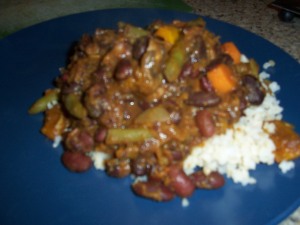 Next on the agenda? Veggie curry.
Next on the agenda? Veggie curry.
Life threw a wrench in the works this week – our microwave went on the blink. Now we don’t use the micro for much, mostly for starting baked potatoes for the grill, melting and thawing. Therein lies the problem. In our quest to avoid sodium, we like to make big batches of beans and keep them in the freezer. Same goes for brown rice. But we’re not always good about getting stuff out of the freezer early on. So we’ll start with directions:
If you didn’t get the beans out in time, and you don’t have a microwave: About 1/2 to 3/4 of an hour before you need them in a recipe, sit the container you froze them in, in a larger container of lukewarm water. This will help them thaw faster. Check from time to time. When they can be broken apart, they can be added to the recipe. This method also works for the rice; to reheat the rest of the way, add a tablespoon or so of water, and heat over low heat on the stovetop, in a non-stick pan. Or use a little oil and some diced celery, onion and mushrooms, and make it fried rice.
To make today’s veggie curry we started by baking a butternut squash. You cut the squash in half, and scoop out the seeds. Turn cut-side-down on a piece of parchment, on a cookie sheet. Bake half an hour (depending on the size, you may need ten more minutes) in a 400F oven. When you can pierce with a fork, it’s ready. Let it cool a bit so you can handle it.
Meanwhile, cook an onion, a stalk of celery, a chopped bell pepper, a couple of sliced carrots, and some mushrooms in a medium-sized pan. Add a couple of cups of cooked kidney beans (check out our bean recipe in the recipe pages). De-glaze with a splash of wine. Pour in a bit of broth (not too much, maybe half a cup). Scoop in half of the squash and save the rest for a delicious soup…within a couple of days, or freeze for later.
Two tablespoons of curry paste are great for our hardy lot…but do it to taste. Use curry powder if you prefer. Or some garam masala, turmeric, and chili powder. Throw in a few green beans or asparagus – whatever’s handy and in season.
Let it simmer until it thickens. Serve with the rice. Your tummy will thank you.
Good Friday Fish: Poached Salmon
 For some folks, Good Friday is just another day off work. But for us, it’s a busy day, filled with opportunities to come together with our community at St. Brigid’s.
For some folks, Good Friday is just another day off work. But for us, it’s a busy day, filled with opportunities to come together with our community at St. Brigid’s.
Fortunately fresh ingredients are easy to find in our neighbourhood. Red peppers, cucumbers, and lettuce from Ontario hothouses are available at Kelly’s, or Plank Road, or Jerry’s Supermarket now. We had the salmon in our freezer, but we can usually get a great selection of fish at the supermarkets on our walking route, like Sobey’s or Valu-Mart.
This dinner starts with boiling the potatoes. While they’re cooking, we’ll bring the water up to a boil for the salmon, and then turn it down to a low simmer, flavouring it with a little citrus pepper and a few slices of lemon. (On another day, white wine would also work nicely). Then we’ll pop in the fish and keep it just gently simmering along while we make the salad.
All that’s left is to give thanks for good food and the latest steps in our Lenten journey, and eat.
Magic Beans!
Easy vegetarian meals often call for canned beans. But in our efforts to watch our weight, we started to learn a lot more about label reading. One thing we’re really careful about is sodium – it makes a huge difference! A rule of thumb we learned was to read the calories per serving on the nutrition label. Then, if the milligrams of sodium per serving is higher than the calorie count, avoid it! Sounds easy, right? Unfortunately it’s the dirty secret of lots of canned foods – they have a lot of sodium. Even healthy choices like beans or soups are a problem. So we make our own beans now, on days when we’re busy working around the house, doing chores, laundry, or whatever. A few weeks ago we made some black-eyed peas…and they’re the star of today’s recipe. We grabbed a one-cup tub out of the 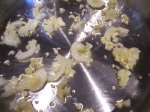 freezer at breakfast time and let it thaw for the day…
freezer at breakfast time and let it thaw for the day…
Then we started dinner by putting some whole wheat pasta on to cook in a big pot of unsalted water. (Two ounces or 60g of dried whole wheat pasta per person is plenty!)
Then, while the past cooks…start a little onion (one small one) and garlic (two cloves) in a couple of teaspoons (10ml) of chili oil. 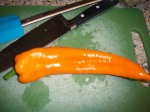 We also chopped in a sweet, sweet pepper we picked up at Plank Road, around the corner. Next, some sliced mushrooms for texture, just rinsed and sliced. Keep stirring as you add the veg.
We also chopped in a sweet, sweet pepper we picked up at Plank Road, around the corner. Next, some sliced mushrooms for texture, just rinsed and sliced. Keep stirring as you add the veg.
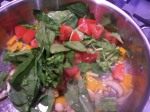 After the pepper, a good big handful of spinach, washed
After the pepper, a good big handful of spinach, washed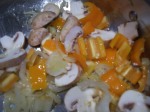 and chopped, and a diced fresh tomato go in the pot. Put the lid on, and turn heat to low for about 5 minutes to wilt the spinach.
and chopped, and a diced fresh tomato go in the pot. Put the lid on, and turn heat to low for about 5 minutes to wilt the spinach.
Finally, it’s time for the beans. Dump them into the pan, along with about a tablespoon (15 ml) of pesto (check the types and buy the one with the least sodium!) 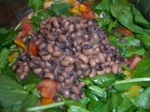 . Pop the lid back on and simmer all of this until it is bubbling hot and ready to receive the pasta – just a few minutes should do. Then tip in the pasta, stir, sprinkle with a little cayenne, and lid the pan again. Let it simmer over very low heat for the flavours to meld.
. Pop the lid back on and simmer all of this until it is bubbling hot and ready to receive the pasta – just a few minutes should do. Then tip in the pasta, stir, sprinkle with a little cayenne, and lid the pan again. Let it simmer over very low heat for the flavours to meld.
Finally, when the flavours have had a chance to come together, serve! If you want, shave a little sharp cheddar on top, but you won’t need too much. An ounce or so should do between the two plates (that’s about 30 grams). Happy eating!
Fresh Fruits and Vegetables are A Secret
One secret to success are fresh fruits and vegetables when you’re trying to lose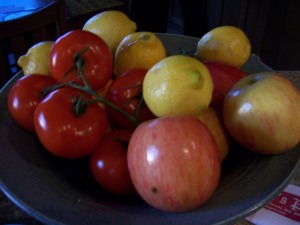 weight and keep in shape. If you combine that with a desire to eat local, and you live in a climate where those things don’t grow all year round, it’s a challenge. We like local. We like farmer’s markets. But let’s face it, some things just don’t grow around here at the best of times. So unlike some locavores, we’re not giving up lemons, or oranges, or coffee, because they come from somewhere else. Our compromise? We compare the ones that are available within a reasonable walk from our house (for us, that’s probably about 30 minutes each way), and buy the ones that come from the closest locale. What we get in return is an opportunity to get to know our local shopkeepers, still have a variety of foods, and to offset our carbon footprint by using…well…our feet!
weight and keep in shape. If you combine that with a desire to eat local, and you live in a climate where those things don’t grow all year round, it’s a challenge. We like local. We like farmer’s markets. But let’s face it, some things just don’t grow around here at the best of times. So unlike some locavores, we’re not giving up lemons, or oranges, or coffee, because they come from somewhere else. Our compromise? We compare the ones that are available within a reasonable walk from our house (for us, that’s probably about 30 minutes each way), and buy the ones that come from the closest locale. What we get in return is an opportunity to get to know our local shopkeepers, still have a variety of foods, and to offset our carbon footprint by using…well…our feet!
Searching for Spring
 As we go around the neighbourhood searching for spring, it’s almost as if we’re wishing away the time. On the upside, Carter’s is open for the season (hurray)! Still no Farmer’s Market action, but we’re hopeful.
As we go around the neighbourhood searching for spring, it’s almost as if we’re wishing away the time. On the upside, Carter’s is open for the season (hurray)! Still no Farmer’s Market action, but we’re hopeful.
In the meantime we have some lamb chops and salad stuff, and we’re planning on grilling. That can make us feel like spring, anytime! The lamb chops are marinating in a little olive oil (we’re blessed with lots of great EVOO sources that are walkable), some red wine vinegar, a few spring onions from the urban farm (or backyard, to the uninitiated), some chopped garlic, and a tablespoon or so of dried oregano…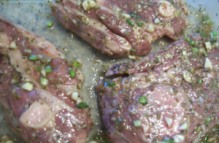
These are just some discount grocery store chops we got down the street…not beautifully-trimmed butcher chops. But with a little TLC, they’re gonna taste great!
There's Never Enough Bread
This week’s bread: multigrain!
When I posted the recipe for whole wheat bread, I mentioned that you can dress it up, or dress it down. You can also turn it into a completely different kind of bread…and suddenly it’s not just whole wheat any more.
This one’s multi-grain. (Don’t worry…those dark brown spots are a couple of stowaway raisins that got into the recipe!)
Instead of the six cups of whole wheat flour, for this batch I used two of whole wheat, two of rolled oats, and two of cornmeal. I also tossed in half a cup of flax seeds that needed to get used up. The recipe takes the same amount of white flour as in the original recipe, and all the other instructions are exactly the same.
Are you Egging me On?
 Everywhere we walk, we’re seeing eggs. Real eggs. Wooden eggs. Easter eggs. Wreaths of crazy-coloured plastic eggs. Tis the season!
Everywhere we walk, we’re seeing eggs. Real eggs. Wooden eggs. Easter eggs. Wreaths of crazy-coloured plastic eggs. Tis the season!
I used to struggle with egg-making, but a couple of wise women taught me everything I needed to know about boiled eggs. First, a disclaimer: I know that some people are not too keen on soft-boiled eggs. We grew up eating them, and we’re a-okay. But if you have a compromised immune system, or you’re pregnant, or elderly, or feeding eggs to a child under six, food safety experts suggest hard-boiled eggs are safest.
For a soft-boiled egg, place the egg in a pot of boiling water, and cook 6-7 minutes until the whites are completely set and the yolk is soft but heated through. (Sorry, if I could figure out how you could tell without sacrificing an egg, I’d let you know). For hard boiled, ten minutes should do the trick. Store cooked, hard-boiled eggs in the fridge for up to a week.
Make Yourself Comfortable
 Sometimes comfort food is what you need. I’d put tuna sandwiches on the menu plan, but it was a cold day. There were too many things on my plate.
Sometimes comfort food is what you need. I’d put tuna sandwiches on the menu plan, but it was a cold day. There were too many things on my plate.
Earlier in the week we had picked up some delicious Black River Cheddar at Better Bulk. It is creamy, crumbly, sharp, and completely awesome. It’s the kind of cheddar that makes anything better!
The melts started with some toasted whole wheat bread. For the topping (makes enough for four slices): 1 can of water-pack tuna, 1 tomato, diced, and a tablespoon or 15ml each of Dijon and light mayo. If you have some herbs, by all means, chop them in. I used dill. Mix this and put on the bread, on a broiler-proof pan. Grate on some cheddar. Under the broiler til bubbly, and you’re set. Don’t forget the pickle!
Mmm…Yeasty Goodness
 My bread obsession knows no bounds. This batch, just getting ready for the second rising, is whole wheat. When I was a kid, my grandmother would make most of our bread – sometimes every day. I would have preferred the squishy white bread that some of the other kids had in their lunches. I didn’t know how good I had it!
My bread obsession knows no bounds. This batch, just getting ready for the second rising, is whole wheat. When I was a kid, my grandmother would make most of our bread – sometimes every day. I would have preferred the squishy white bread that some of the other kids had in their lunches. I didn’t know how good I had it!
On the left is my “fancy loaf”. Most of the recipes I make yield four loaves, allowing a more energy-efficient use of the oven (and the bread-making hands). So I always do something special with at least one. In this case, when shaping the loaf, I sprinkled in oregano and snippets of sundried tomato. Then I also sprinkled a little oregano on top. Perfect for a savory accompaniment to some cold-day food.
Sure, the bread-making tends to fall off a little in the summer when it gets too hot. But as much as possible, I prefer to make my own rather than buy it in a store. I guess my grandmother was a pretty smart cookie after all! (And speaking of cookies…naw, let’s save that for another time).

